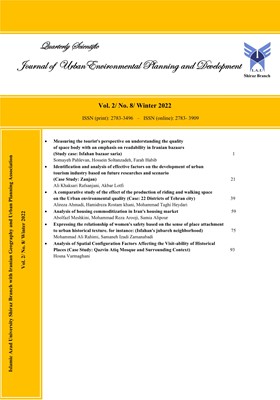-
-
List of Articles
-
Open Access Article
1 - Measuring the tourist's perspective on understanding the quality of space body with an emphasis on readability in Iranian bazaars. (Study case: Isfahan bazaar saria)
Somayeh pahlevan hossein soltanzadeh farah habib -
Open Access Article
2 - Identification and analysis of drivers affecting the development of the urban tourism industry with an emphasis on foresight and scenario writing (case study: Zanjan city)
Ali Khaksari Rafsanjani Akbar Lotfi -
Open Access Article
3 - A comparative study of the effectiveness of the production of riding and walking space on the quality of the urban environment (Case: 22 Districts of Tehran city)
Alireza Ahmadi hamidreza rostamkhani mohamad taghi heydari -
Open Access Article
4 - Analysis of housing commoditization in Iran's housing market
Abolfazl meshkini Mohammad Reza orogi Somayeh Alipour -
Open Access Article
5 - expressing the relationship of women's safety based on the sense of place attachment to urban historical texture. for instance: (Isfahan's jubareh neighborhood)
Mohammad Ali Rahimi Samaneh Izadi Zamanabadi -
Open Access Article
6 - Analysis of Spatial Configuration Factors Affecting the Visit-ability of Historical Places (Case Study: Qazvin Atiq Mosque and Surrounding Context)
Hosna Varmaghani
-
The rights to this website are owned by the Raimag Press Management System.
Copyright © 2021-2025







